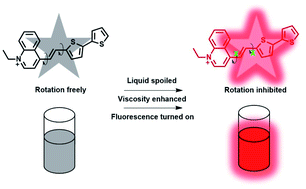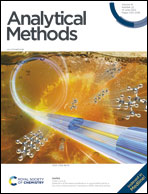Activatable molecular rotor based on bithiophene quinolinium toward viscosity detection in liquids†
Abstract
The development of non-invasive and effective viscosity inspection methods during the liquid deterioration process is urgently needed since viscosity is one of the most important physical parameters of liquids. Methods featuring rapid detection, high sensitivity, cheap equipment, and fast result output are greatly desired. In this study, a viscosity-sensitive molecular rotor (BTPEQ) with a large Stokes shift (187 nm), and long emission wavelength (648 nm) has been developed. The rotor is comprised of a bithiophene donor and quinolinium acceptor, and displays a typical twisted intramolecular-charge transfer (TICT) feature, with good photostability, selectivity, and universality in various commercial liquids. With the aid of BTPEQ, the thickening effects of liquid thickeners can be determined. More importantly, BTPEQ was explored to visualize the viscosity variations in liquids at different metamorphic stages, and it was found that the viscosity level in microenvironments is highly dependent on the liquid food metamorphic period. It is worth noting that this approach can facilitate the continued perfection of fluorescent analytical methods for food quality and safety inspection.



 Please wait while we load your content...
Please wait while we load your content...